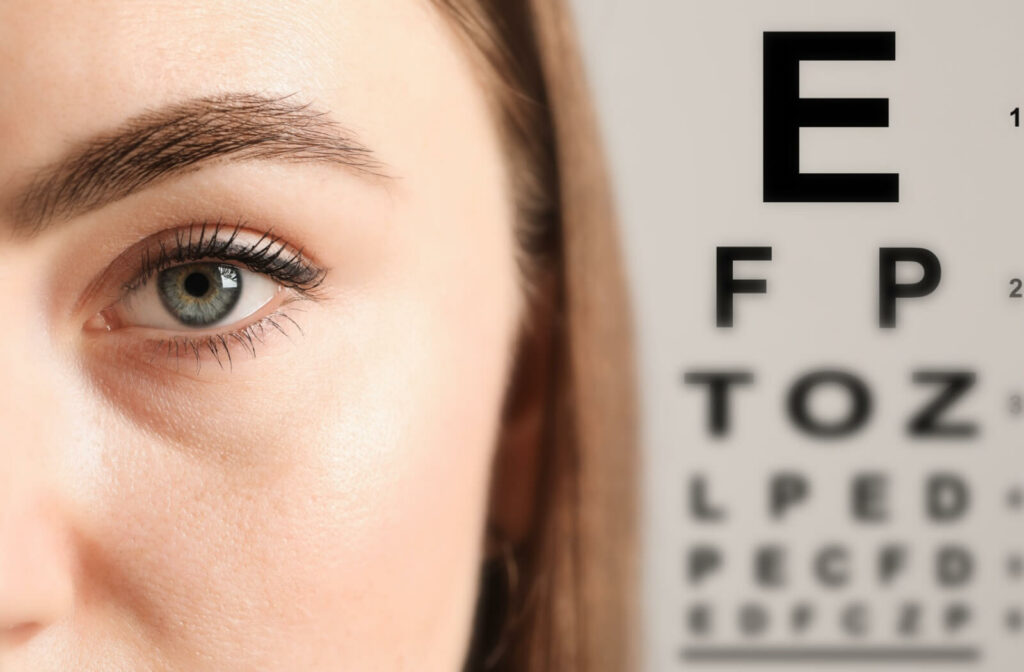Astigmatism and myopia—you’ve probably come across these terms during an eye exam or a conversation about vision. While both conditions affect how we see the world, they do so in different ways. The main difference is that astigmatism causes blurry vision at all distances, whereas myopia (nearsightedness) makes objects in the distance appear blurry while close-up objects remain clear.
Fortunately, your optometrist can improve both conditions with corrective lenses. Whether you need new frames or want to stay active with contact lenses, astigmatism or myopia won’t hold you back.
How Myopia Affects Vision
Myopia, also known as nearsightedness, occurs when the eye’s shape causes light to focus incorrectly in front of the retina rather than directly on it. This often happens because the eyeball is too long or the cornea has too much curvature. In either case, you’ll have to deal with blurred vision when trying to see distant objects, though close-up vision remains clear.
Other signs and symptoms of myopia can include:
- Frequent squinting
- Difficulty seeing road signs, whiteboards, or digital screens from a distance
- Eyestrain or headaches from trying to focus
- Holding books or screens very close to your face
Myopia often develops during childhood while the eyes are still growing. Genetics play a significant role—children with one or both parents who have myopia are more likely to develop it themselves. Lifestyle factors, such as spending too much time focusing on close-up tasks (like reading or screen use), have also been linked to myopia in children.
Optometrists have been dealing with myopia for a long time, so we have a few treatments available, including:
- Eyeglasses or contact lenses: The easiest way to correct myopia is with prescription lenses, featuring a concave shape to redirect light properly onto the retina.
- Laser surgery: Procedures like LASIK permanently reshape the cornea for clearer distance vision.
- Myopia management (for children): Options like specialty glasses, contact lenses, or prescription eye drops can slow the progression of myopia.
If your child is diagnosed with myopia, starting management early can significantly improve their long-term outcomes.
What Is Astigmatism?
Astigmatism occurs when the cornea or lens of the eye has an uneven shape, causing light to scatter instead of focusing neatly onto the retina. Think of it as if the eye is shaped more like a football than it should be a basketball. Unlike myopia or hyperopia (farsightedness), astigmatism affects vision at all distances, making it appear blurry or distorted.
You may also experience:
- Difficulty focusing, often accompanied by squinting
- Eyestrain or headaches, especially after prolonged screen time or reading
- Challenges with night driving due to glare or poor depth perception
Astigmatism is often present from birth and may occur alongside myopia or hyperopia. In rare cases, it can result from an eye injury, surgery, or a condition like keratoconus, where the cornea becomes progressively thinner and more irregular in shape.
Your optometrist can treat astigmatism much like they can treat myopia:
- Eyeglasses: Specially-made corrective lenses can help balance astigmatic distortions.
- Laser surgery: Procedures like LASIK can reshape the cornea to restore proper focus.
- Specialty lenses: Most contact lenses don’t fit an eye with astigmatism because it’s so irregularly shaped. That doesn’t mean you’re out of luck. Rigid gas-permeable or toric lenses can help people still enjoy the benefits of contact lenses.
Identifying astigmatism early and managing it effectively can significantly improve your vision and daily comfort.
Key Differences Between Astigmatism & Myopia

It can appear as though astigmatism and myopia are very similar, but let’s break down some of the symptoms:
Visual Symptoms
- Astigmatism: Causes blurry or distorted vision at all distances. Double or shadowed vision is also common, especially when focusing on fine details.
- Myopia: Primarily affects distance vision, causing faraway objects to appear blurred while close objects remain clear.
Diagnosis
- Astigmatism: This could appear like myopia during a vision test since everything will be blurry, but an optometrist can diagnose it using tools like a keratometer (to measure corneal curvature) or corneal topography (to map the cornea’s surface).
- Myopia: Diagnosed during a standard vision test to measure distance vision.
Daily Impact
- Astigmatism: This may affect all activities that require sharp vision, like reading, working on a computer, or driving at night.
- Myopia: Often makes tasks like reading road signs, watching movies, or playing sports more difficult, but some activities requiring close work may be unaffected. It depends on the severity.
While these conditions differ, both can impact your ability to enjoy life to the fullest if left uncorrected.
The Importance of Regular Eye Exams
Even as adults, our eyes are constantly changing. Conditions like astigmatism and myopia are often first diagnosed in children, whose eyes are growing each and every day. Regular eye exams are essential for identifying these conditions early—and many more like them.
Optometrists can use advanced diagnostic tools to evaluate your overall eye health, detect refractive errors, and monitor for conditions like cataracts or glaucoma. Even if you aren’t experiencing noticeable symptoms, a yearly comprehensive eye exam can uncover underlying issues and help your prescription remain accurate.
See the World Clearly with Us
Your eyes deserve expert care, whether you’re managing myopia or astigmatism or simply keeping your vision in check. With a focus on personalized solutions, Milton Vision & Sports Vision Training Centre is here to help you get back to seeing the world clearly and confidently.
Our team provides tailored treatments backed by diagnostic tools and a welcoming environment for all your eye care needs. We’re passionate about helping people see the world clearly.
If you’ve been holding off on your eye exam, now is the time to prioritize your vision and book an appointment.



